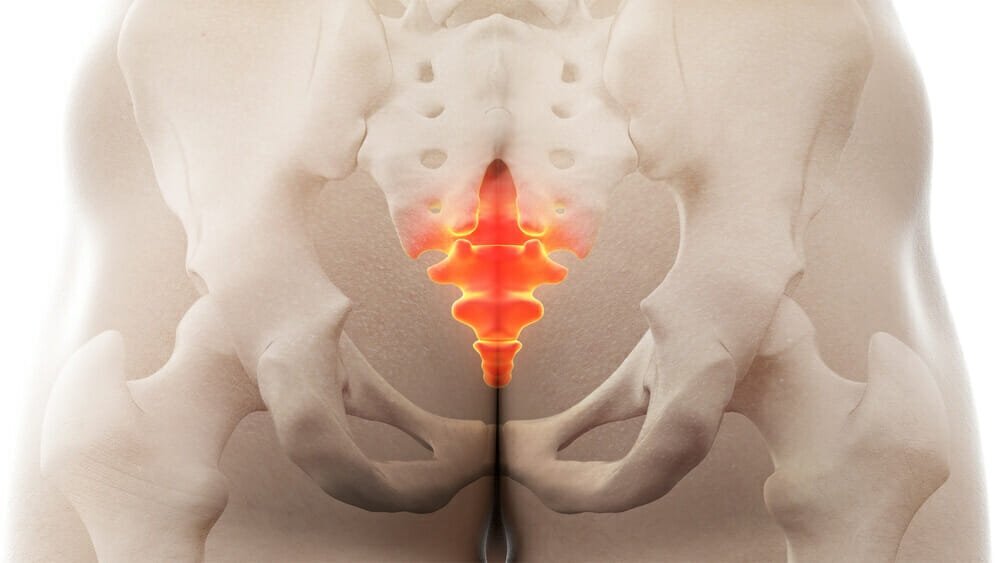Exercises and Tips to Relieve Tailbone Pain
Tailbone pain aka coccydynia is a common diagnosis seen in the pelvic floor PT world. It can be caused by trauma (fall, childbirth), increased pressure (cyclists, sitting all day). postural influence, and more.
The coccyx is the tiny bone that attaches to the end of the sacrum. This joint is flexible - it can flex, extend, rotate and sidebend as it is influenced by some of the muscular attachments. Some of the pelvic floor muscles insert directly onto the coccyx, which means increased or uneven tension could contribute to pain.
Here are three exercises for relieving tailbone pain:
1. Deep breathing for posterior pelvic floor expansion
One of the first steps in finding relief for tailbone pain is to decrease tension in the pelvic floor muscles - usually along the backside. Breath can be one of the most powerful tools to find expansion and lengthening of the pelvic floor muscles. But it can also be challenging for some to connect with.
I’ll often have people lie over a ball or bench, or fold a pillow and place under the abdomen. In this position, your front side can be “blocked” so that your expansion can be targeted more to the back side of the body. In this position, practice taking some deep inhales. Allow the ribcage to expand. Think about “breathing into your butthole” - I wish there was a less direct way to say this but it’s true! Take deep inhales through the nose and send your breath into the posterior pelvic floor. You should feel a subtle expansion - I tell my patients to picture a flower blooming from the anus.
In the video, I’m trying to illustrate the expansion that you are feeling as you take the inhale. On the exhale, just let the muscles recoil - no contracting. If you still have trouble feeling it, try putting your hips into internal rotation (ankles out) and try again.
2. Hip shifts with pelvic tilts
I love this exercise for a plethora of pelvic floor dysfunctions, but it is especially great for treating tailbone pain. Place a yoga block under your knee and shift most of your weight through this leg. This allows drives your femur bone back into the pelvis, creating an expansion in the backside of the hip/pelvic floor. Hold the weight shift and then perform a cat/cow. As you go into the anterior tilt / “cow”, you should feel more stretch and expansion through that area.
Perform this on both sides, or if one side is more symptomatic, spend more time there!
3. Pelvis internal and external rotation on block
Now that we’ve worked on lengthening and mobility, it’s important to actively move these muscles through their full range of motion. Using the same block, actively press the knee into the block while rotating the opposite side of the pelvis towards the ceiling. Lower the pelvis back down by slowing rotating back into the starting position. The hip that is on the block is doing the work - serving as the axis point. Take a look at the video for a visual:
Other helpful tips…
In addition to movement and exercise, there are other ways to supplement treating tailbone pain.
Posture
Standing posture - avoid clenching your glutes when standing. Over clenching leads to tightness and increased tension around the tailbone. Avoid always favoring the same hip with carrying child or in standing posture. Try to shift weight evenly or trade off hips.
Sitting posture - avoid sacral sitting (tucking tailbone and weightbearing through tailbone) and aim to sit on your sit bones! Being more upright will allow weight to distribute through other parts of the pelvis other than the tailbone. Avoid sitting for long hours. Try to get up and move around for a few minutes each hour.
Use a tailbone cushion
Sitting is often a main complaint for those with tailbone pain. Unfortunately, many people still need to sit at a desk for work. Using a tailbone cushion can be a good way to manage symptoms and still be able to complete work tasks. I’ll link here the one I recommend on Amazon.
Implementing some of these changes can be a big difference when it comes to treating tailbone pain. If you are struggling to figure it out, a pelvic floor PT is an amazing resource to have in creating an individualized plan for you. This patient population benefits from some hands on treatments like soft tissue mobilization to the pelvic floor and surrounding hip muscles, mobilizing the hips, and strengthening the muscles surrounding the pelvis.

